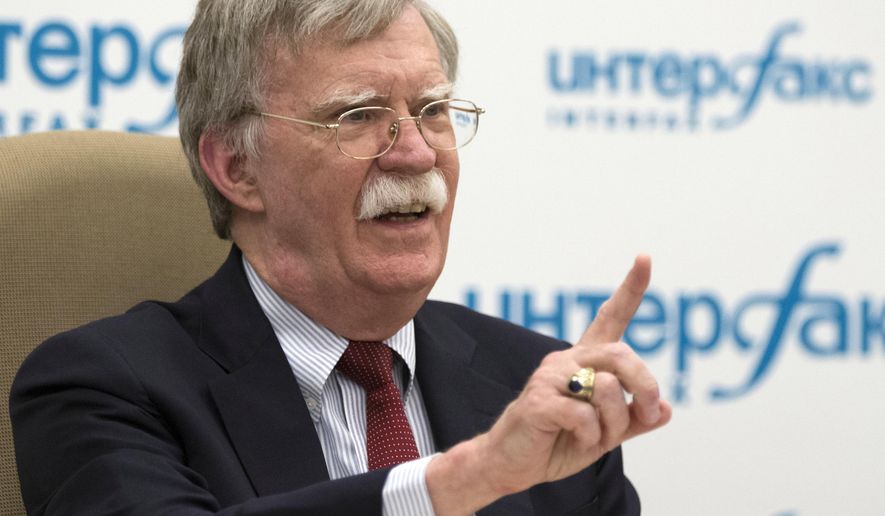Trump administration officials say North Korea’s nuclear program could be fully dismantled in one year, laying out an ambitious time frame if Kim Jong-un’s regime cooperates with the U.S.
The claim, made by White House National Security Adviser John R. Bolton during a round of TV interviews Sunday, comes as the Trump administration is quietly accelerating negotiations with North Korea in what analysts describe as the crucial next step that will make or break the denuclearization agreement struck at the Singapore summit.
If those negotiations succeed and the denuclearization process moves ahead, Mr. Bolton says the administration believes it can accomplish its goal fast.
“If they have the strategic decision already made to do that, and they’re cooperative, we can move very quickly,” he told CBS’ “Face the Nation” program. “What our experts have devised is a program that with North Korean cooperation we can get physically — we would be able to dismantle the overwhelming bulk of their programs within a year.”
Meanwhile, the U.S. team wants to put some meat on the bone of the four-point declaration signed June 12 in Singapore by President Trump and Mr. Kim. They are prodding Pyongyang to provide a full inventory of its nuclear weapons program and to agree on a timeline for dismantling it, though it’s not yet clear whether Mr. Kim would agree to the kind of ambitious timetable Mr. Bolton laid out Sunday.
“There will be specific asks and there will be a specific timeline when we present the North Koreans with our concept of what implementation of the summit agreement looks like,” a senior U.S. defense official told Reuters and other reporters during Defense Secretary James N. Mattis recent trip to China.
The accuracy and completeness of the inventory, which the U.S. will able to partially verify based on spy satellite images and other intelligence, will tell whether North Korea is serious about giving up the nukes.
“We’ll know pretty soon if they’re going to operate in good faith or not,” said the official.
Stanford University researcher Siegfried Hecker, a former director of Los Alamos National Laboratory and authority on global nuclear threat reduction, said this was the tough part of a denuclearization deal with notoriously deceptive North Korea.
“The summit took a big step away from the brink of war and opened the door to constructive dialogue. The hard work is yet to come,” he told The Washington Times.
Mr. Hecker and two colleagues at Stanford’s Center for International Security and Cooperation compiled an estimate of North Korea’s nuclear arsenal and developed a six- to 10-year timeline to dismantle the program fully.
Prior to the summit, North Korea already took some of the most important first steps outlined by a white paper titled “A Technically-informed Roadmap for North Korea’s Denuclearization.” Those steps included halting nuclear and missile tests and destroying the Punggye-ri nuclear test site.
Big questions remain, however, about the reclusive communist regime’s uranium enrichment facilities and production of H-bomb fuels.
“North Korea has covert facilities that it is unlikely to declare and eliminate initially,” wrote the scientists. “We believe that early access to the known Yongbyon centrifuge facility and halting operations of the uranium chemical processing facilities that support all enrichment activities are the most important initial steps.”
At the same time, Mr. Bolton and other officials say they’re well aware that, in the past, North Korea has used the pretext of negotiations to continue on with its nuclear programs in secret.
“We know exactly what the risks are of them using negotiations to drag out the length of time they have to continue their nuclear, chemical, biological programs and ballistic missiles,” Mr. Bolton said.
The absence of tangible progress in the weeks following the Singapore summit tested the patience of some Congress members in Mr. Trump’s Republican Party and even South Korea President Moon Jae-in.
“It’s necessary for North Korea to present far more concrete denuclearization plans, and I think it’s necessary for the United States to swiftly reciprocate by coming up with comprehensive measures,” Mr. Moon said just days after the summit.
Some of frustration came from Mr. Kim’s failure to follow through on his promise to immediately destroy the Sohae Satellite Launching Ground, a missile engine test facility in Ch’olsan County, North Pyongan province. More than two weeks later, it is unclear if any steps have been taken to decommission the plant.
Mr. Kim made the promise to Mr. Trump in Singapore but the pledge wasn’t memorialized in the four-point declaration signed by the two leaders.
Satellite images of the missile test site taken immediately after the summit have shown no activity suggesting it was being dismantled. A National Security Council official told The Washington Times that they are not yet alarmed but are closely monitoring the site.
Mr. Trump insisted the talks are moving “very quickly” and that he believed North Korea is serious about total denuclearization.
At a June 23 event in Nevada, the president said the relationship he forged with Mr. Kim is paying dividends.
“We have a good chemistry together. We get along great. He’s a smart, tough guy. He’s a great negotiator,” he said.
• S.A. Miller can be reached at smiller@washingtontimes.com.
• Ben Wolfgang can be reached at bwolfgang@washingtontimes.com.




Please read our comment policy before commenting.